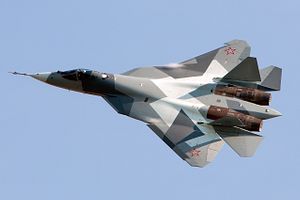Russia’s fifth-generation T-50 (PAK FA) multi-role fighter jet will be armed with an extended range Kh-35UE tactical cruise missile, according to Russian media reports citing the missile’s developer, Russian defense contractor Tactical Missile’s Corporation JSC.
Russian defense experts speaking to Izvestia newspaper claim that the potential new armament will turn the new fighter jet into a “multi-functional fighting machine.” The T-50 (PAK FA) — the name will change for the production aircraft — is a fifth-generation multi-role, single seat, twin-engine air superiority/deep air support fighter presently under development.
Nicknamed “Harpoonski” [Kharpunskiy] due to its similarity to the U.S.-made Harpoon anti-ship missile, the Kh-35UE is a subsonic, sea-skimming anti-ship cruise missile armed with a 145 High Explosive (HE) fragmentation, penetration warhead.
The latest Kh-35 variant featuring an improved propulsion system purportedly doubles the missile’s range from 130 to 260 kilometers, providing the T-50 (PAK FA) with a stand-off capability, which enables the aircraft to launch the missile while staying out of range of enemy air defenses.
Given the size of the missile, it will likely not be carried inside the T-50’s internal weapons bay but under the aircraft’s wings, which will reduce the fighter jet’s stealthiness. According to the Tactical Missile Corporation JSC, a number of successful tests of the KH-35UE on the T-50 (PAK FA) have been completed.
The Kh-35UE can be launched from multiple platforms, including coastal defense missile systems and rotary aircraft. Depending on the launch platform, the missile configurations varies. For example, the helicopter-launched version is slightly longer and heaver than the fixed-wing aircraft variant (4.4 meters versus 3.85 m, and 650 kilograms versus 550 kg) and can also be launched at lower altitudes.
“Target acquisition and designation data can be fed into missile’s guidance system from both ship-based and external target data sources,” according to the Tactical Missile’s Corporation JSC website. “The missile has low signatures thanks to its small dimensions, sea-skimming capability and a special guidance algorithm ensuring highly secure operational modes of the active radar seeker.”
The Kh-35UE is designed to take out vessels up to 5,000 tons. Modern warships equipped with the latest variant of the Aegis Combat System should be capable of successfully defending against a KH-35UE attack. The missile has never been used in combat so far and its capabilities under warfighting conditions remain untested.
While the missile is already operational with Russian forces, the induction date of its possible launch platform remains uncertain. As I reported elsewhere, “eight prototypes of the PAK FA underwent flight trials in 2016. Several hundred test flights have taken place so far. One of the main technical hurdles to overcome, however, remains designing and producing a new engine for the aircraft.”
“The fifth-generation engines still do not exist, and the PAK FA still flies on modified engines from the Su-27, Su-30, and other aircraft from that series,” according to a Russian aviation expert.“I think it will have speeds of 1.6 Mach [about 1,200 miles per hour], depending on the location over which the flight takes place. The engine will also improve the PAK FA’s stealth capacity thanks to new composite materials.”
Various reports indicate that Russia is still struggling with the engine development. The Russian Air Force expects the delivery of the first six out of a total of 55 aircraft (some sources say 18-24 fighter jets) by the end of 2018.































